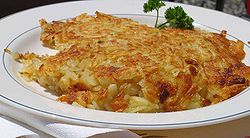Rösti
 A plate of rösti with a parsley garnish | |
| Alternative names | Potato Pancakes (Acadian dish) |
|---|---|
| Type | Side dish |
| Place of origin | Switzerland |
| Region or state | Canton of Bern |
| Main ingredients | Potatoes, butter or other fat |

Rösti or rööschti (Alemannic German: [ˈrøːʃti]) is a Swiss dish consisting mainly of potatoes, in the style of a fritter. It was originally a breakfast dish, commonly eaten by farmers in the canton of Bern, but is now eaten all over Switzerland and around the world. The French name röstis bernois makes direct reference to the origins of the dish.
Many Swiss people consider rösti to be a national dish.[1] Rather than considering it a complete breakfast, lunch or dinner, it is more commonly served to accompany other dishes such as Spinat und Spiegelei (spinach and fried eggs, sunny side up), cervelas or Fleischkäse. It is commonly available in Swiss restaurants as a replacement for the standard side dish of a given meal.[citation needed]
Preparation[]
Rösti dishes are made with coarsely grated potato, either parboiled or raw.[1] Rösti are most often pan-fried and shaped in the frying pan during cooking, but they can also be baked in the oven. Depending on the frying technique, oil, butter, cheese, or another fat may be added (and usually salt and pepper). The grated potatoes are shaped into rounds or patties, usually measuring between 3 and 12 cm (1 and 5 in) in diameter and 1 and 2 cm (0.4 and 0.8 in) thick.[citation needed]
Although basic rösti consists of nothing but potato, a number of additional ingredients are sometimes added, such as bacon, onion, cheese, apple or fresh herbs. This is usually considered to be a regional touch.
In Palau, instead of potato, rösti is prepared from the grated corm of taro.
Cultural impact[]
In Swiss popular cultural ethos, rösti are predominantly eaten in German-speaking regions, although they can be found easily elsewhere in the country. Rösti dishes are portrayed as a stereotypical part of the Swiss-Germanic culture, as opposed to Latin culture. The geographic border separating the French- and German-speaking parts of the country is therefore commonly referred to as the Röstigraben: literally the "rösti ditch".
See also[]
- Hash browns, a similar American dish
- Maluns, another Swiss fried potato dish essentially eaten in the Grisons
- List of potato dishes
- Liechtensteiner cuisine
References[]
- ^ Jump up to: a b Cloake, Felicity (13 October 2011). "How to cook the perfect rösti". The Guardian. Retrieved 19 July 2016.
External links[]
| Wikimedia Commons has media related to Rösti. |
- Potato dishes
- Swiss cuisine
- National dishes
- Culinary Heritage of Switzerland
- Culture of Bern
- Liechtenstein cuisine
- Palauan cuisine
- Vegetarian cuisine
- Breakfast dishes
- Fried foods